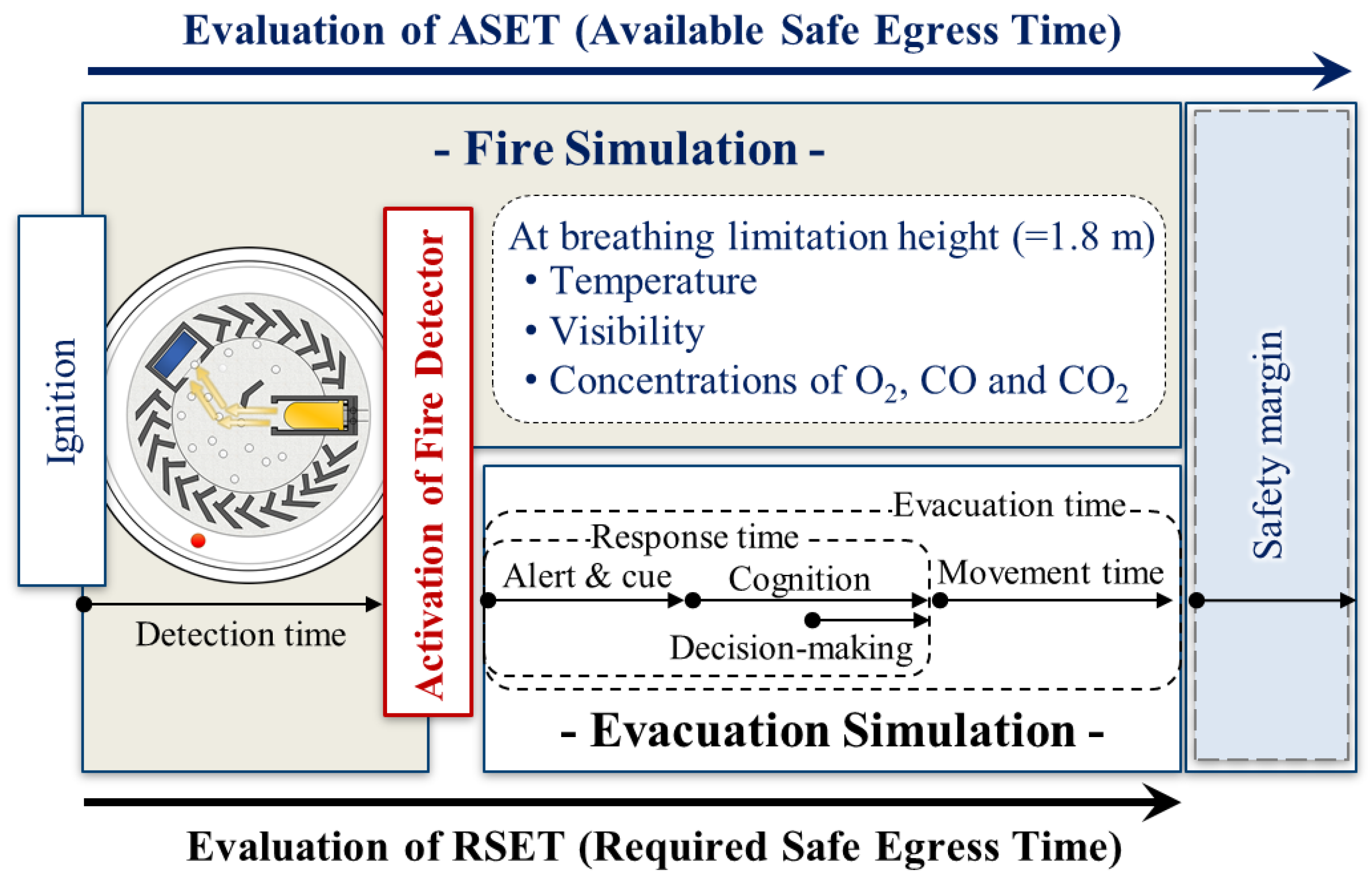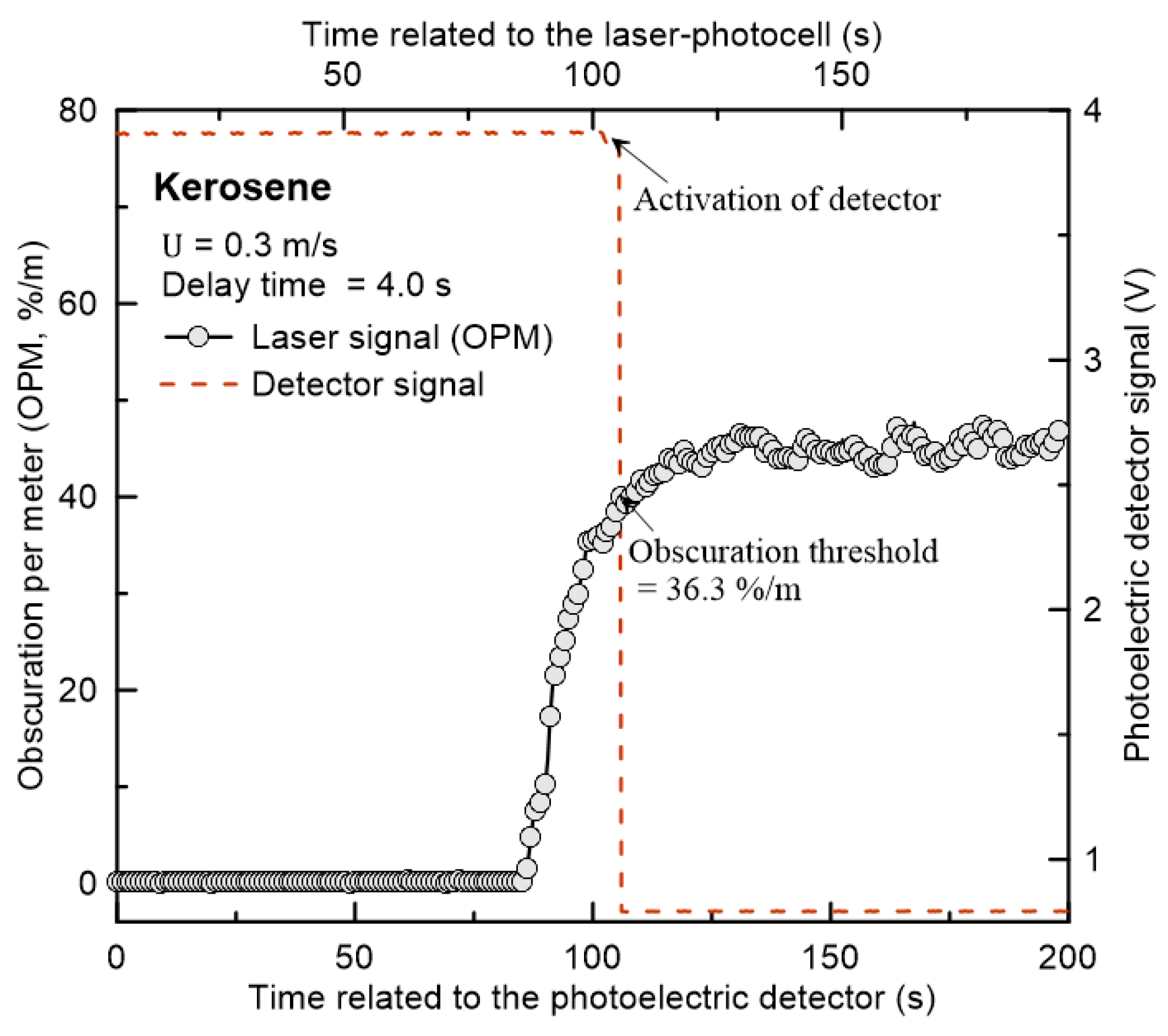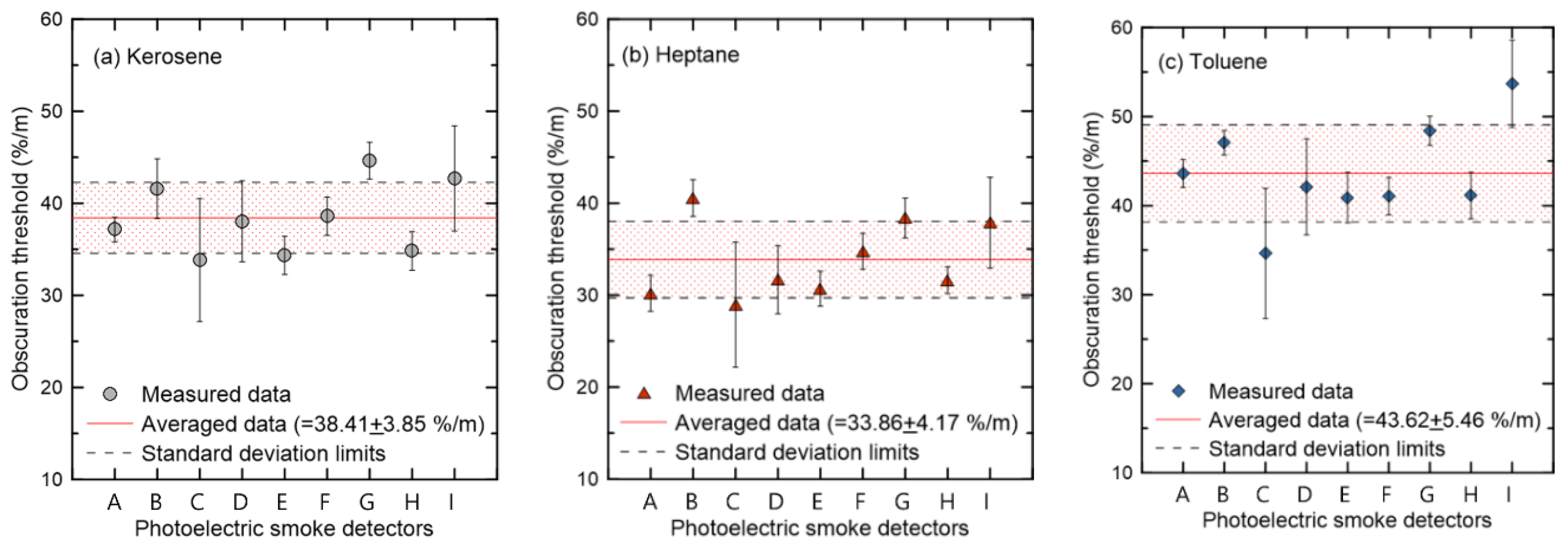Obscuration Threshold Database Construction of Smoke Detectors for Various Combustibles
Abstract
:1. Introduction
2. Experimental Conditions
2.1. Experimental Method and Procedures
2.2. Selection of Smoke Detectors and Smoke Generators for Various Combustibles
3. Results and Discussion
3.1. Obscuration Threshold of Ionization and Photoelectric Detectors according to Smoke Particle Colors
3.2. Database Construction of the Obscuration Thresholds with Liquid Fuels and Polymer Pellets for Various Models of the Photoelectric Smoke Detector
4. Conclusions
Author Contributions
Funding
Conflicts of Interest
Abbreviations
| PBD | Performance-Based Fire Safety Design | Lp | Light Path Length [m] |
| ASET | Available safe egress time | FDE | Fire detector evaluator |
| RSET | Required safe egress time | DB | database |
| FDS | Fire dynamics simulator | PE | Polyethylene |
| L | Characteristic length [m] | PP | Polypropylene |
| U | Free stream velocity [m/s] | PU | Polyurethane |
| Dwell time | PVC | Polyvinyl chloride | |
| Mixing time | PS | Polystyrene | |
| , , , | Additional input parameters | SSA | Single scattering albedo |
| OPM | Obscuration per meter [%/m] | Km | Mass specific extinction coefficient [m2/g] |
References
- Beck, V.R. Performance-based fire engineering design and its application in Australia. Fire Saf. Sci. 1997, 5, 23–40. [Google Scholar] [CrossRef] [Green Version]
- Purser, D.A. ASET and RSET: Addressing some issues in relation to occupant behavior and tenability. Fire Saf. Sci. 2003, 7, 91–102. [Google Scholar] [CrossRef] [Green Version]
- Proulx, G. Movement of people: The evacuation timing. In SFPE Handbook of Fire Protection Engineering, 3rd ed.; Section 3; DiNenno, P.J., Drysdale, D., Beyler, C.L., Walton, W.D., Custer, R.-P., Hall, J.R., Watts, J.M., Eds.; Society of Fire Protection Engineers: Gaithersburg, MD, USA, 2002; pp. 342–366. [Google Scholar]
- Poon, S.L. A dynamic approach to ASET/RSET assessment in performance based design. Proc. Eng. 2014, 71, 173–181. [Google Scholar] [CrossRef] [Green Version]
- Yan, Z.; Han, X.; Li, M. Accurate assessment of RSET for building fire based on engineering calculation and numerical simulation. In Proceedings of the MATEC Web of Conference, APOP2016, Shanghai, China, 28–29 May 2016; Volume 61, p. 04024. [Google Scholar] [CrossRef] [Green Version]
- Xing, Z.-X.; Zhao, X.-F.; Song, H.; Gao, W.-L. Applied research of performance-based fire protection design in a large building. Proc. Eng. 2011, 11, 566–574. [Google Scholar] [CrossRef] [Green Version]
- McGrattan, K.; Hostikka, S.; McDermott, R.; Floyd, J.; Vanella, M.; Weinschenk, C.; Overholt, K. Fire Dynamics Simulator User’s Guide, 6th ed.; NIST Special Publication 1019; National Institute of Standard and Technology: Gaithersburg, MD, USA, 2017.
- Zhang, W.; Klassen, M.; Roby, R. Numerical prediction of smoke detector activation accounting for aerosol characteristics. Fire Saf. Sci. 2005, 8, 1543–1554. [Google Scholar] [CrossRef] [Green Version]
- Heskestad, G. Generalized characteristics of smoke entry and response for products-of-combustion detectors. In Proceedings of the 7th International Conference on Problems of Automatic Fire Detection, Rheinish-Westfalischen Technischen Hochschule Aachen, Aachen, Germany, 31 March–1 April 1975; pp. 267–310. [Google Scholar]
- Björkman, J.; Kokkalal, M.A.; Ahola, H. Measurement of the characteristic lengths of smoke detectors. Fire Technol. 1992, 28, 99–106. [Google Scholar] [CrossRef]
- Mowrer, F.W. Lag times associated with fire detection and suppression. Fire Technol. 1990, 26, 244–265. [Google Scholar] [CrossRef]
- Marrion, C.E. Lag Time Modeling and Effects of Ceiling Jet Velocity on the Placement of Optical Smoke Detectors. Master’s Thesis, Worcester Polytechnic Institute, Center for Fire Safety Studies, Worcester, UK, 1989. [Google Scholar]
- Cleary, T.; Chernovsky, A.; Grosshandler, W.; Anderson, M. Particulate entry lag in spot-type smoke detectors. Fire Saf. Sci. 2000, 6, 779–790. [Google Scholar] [CrossRef]
- Kim, K.H.; Hwang, C.H. Measurement of the device properties of a ionization smoke detector to improve predictive performance of the fire modeling. J. Kor. Inst. Fire Sci. Eng. 2013, 27, 27–34. [Google Scholar] [CrossRef] [Green Version]
- Cho, J.H.; Mun, S.Y.; Hwang, C.H.; Nam, D.G. Measurement of the device properties of photoelectric smoke detector for the fire modeling. Fire Sci. Eng. 2014, 28, 62–68. [Google Scholar] [CrossRef] [Green Version]
- Jang, H.Y.; Hwang, C.H. Revision of the input parameters for the prediction models of smoke detectors based on the FDS. Fire Sci. Eng. 2017, 31, 44–51. [Google Scholar] [CrossRef]
- Jang, H.Y.; Hwang, C.H. Methodology for DB construction of input parameters in FDS-based prediction models of smoke detector. J. Mech. Sci. Technol. 2020. in review. [Google Scholar]
- D’souza, V.T.; Sutula, J.; Olenick, S.; Zhang, W.; Roby, R. Predicting smoke detector activation using the fire dynamics simulator. Fire Saf. Sci. 2003, 7, 187–195. [Google Scholar] [CrossRef] [Green Version]
- Kulkami, V.; Lilley, D.G. FDS: Application of the fire dynamics simulator code to a three-room structure with experimental fires and 60 smoke detectors. In Proceedings of the 47th AIAA Aerospace sciences meeting including the new horizons forum and aerospace exposition, Orlando, Florida, 4–7 January 2011; pp. 1–21. [Google Scholar] [CrossRef]
- Miller, J.-T. Analyzing Photo-Electric Smoke Detector Response Based on Aspirated Smoke Detector Obscuration. M.S. Thesis, University of Maryland, College Park, 2010. Available online: http://hdl.handle.net/1903/10455 (accessed on 22 March 2018).
- Kametani, Y.; Fulkagata, K.; Orlu, R.; Scahlatter, P. Effect of uniform blowing/suction in a turbulent boundary layer at moderate reynolds number. Int. J. Heat Fluid Flow 2015, 55, 132–142. [Google Scholar] [CrossRef]
- Mulholland, G.W.; Johnsson, E.L.; Fernandez, M.G.; Shear, D.A. Design and testing of new smoke concentration meter. Fire Mater. 2000, 24, 231–243. [Google Scholar] [CrossRef]
- Kim, B.J.; Cho, J.H.; Hwang, C.H.; Park, S.H. A study on the development of a low-cost device for measuring the optical smoke density. Fire Sci. Eng. 2015, 29, 81–88. [Google Scholar] [CrossRef] [Green Version]
- Korea Fire Institute (KFI); National Fire Agency. Detailed Inspection Regulations for Model Approval & Inspection Technical Standards for Fire Detectors; National Standards of the Republic of Korea, Korea Fire Institute (KFI); National Fire Agency: Yongin-si, Korea, 2019; pp. 31–34.
- George, W.M. Smoke production and Properties. In SFPE Handbook of Fire Protection Engineering, 3rd ed.; Philip, J.D., Craig, L.B., Eds.; Society of Fire Protection Engineers: Gaithersburg, MD, USA, 2002; Sec. 2–13; pp. 473–484. [Google Scholar]
- Underwriters Laboratories Inc. UL 217, Single and Multiple Station Smoke Detectors, 4th ed.; Underwriters Laboratories Inc., UL: Northbrook, IL, USA, 1993; pp. 50–69. [Google Scholar]
- Underwriters Laboratories Inc. UL 268, Standard for Smoke Detectors for Fire Protective Signaling Systems, 4th ed.; Underwriters Laboratories Inc., UL: Northbrook, IL, USA, 2003. [Google Scholar]
- Matthew, B.; Frederick, W.M.; James, A.M.; Pravinray, G. Validation of a Smoke Detection Performance Prediction Methodology, Characterization of Incipient Fire Sources; Fire Protection Research Foundation: Quincy, MA, USA, 2008; Volume 1, pp. 6–7. [Google Scholar]
- Patrick Arnott, W.; Hans, M.; John, W.W. Nitrogen dioxide and kerosene-flame soot calibration of photoacoustic instruments for measurement of light absorption by aerosols. Rev. Sci. Instrum. 2020, 71, 4545–4552. [Google Scholar] [CrossRef]
- Sujeeta, S.; Marc, N.F.; Solomon, B. Measurement of size-dependent single scattering albedo of fresh biomass burning aerosols using the extinction-minus-scattering technique with combination of cavity ring-down spectroscopy and nephelometry. Atmos. Chem. Phys. 2016, 16, 13491–13507. [Google Scholar] [CrossRef] [Green Version]
- Mulholand, G.W.; Croakin, C. Specific extinction coefficient flame generated smoke. Fire Mater. 2000, 24, 227–230. [Google Scholar] [CrossRef]
- Mulholland, G.W.; Choi, M.Y. Measurement of the mass specific extinction coefficient for acetylene and ethane smoke using the large agglomerate optics facility. Symp. Combust. Proc. 1998, 27, 1515–1522. [Google Scholar] [CrossRef]
- Fire Technology Solution DB. Available online: https://www.kfiredb.com (accessed on 22 March 2018).










| Filter Paper | Kerosene | Heptane | Toluene | PP | PVC | PU | PE | PS | |
|---|---|---|---|---|---|---|---|---|---|
| Ionization detector | 39.2 | 16.4 | 11.1 | - | - | - | - | - | - |
| Photoelectric detector | 16.2 | 38.4 | 33.9 | 43.6 | 19.7 | 30.4 | 24.0 | 19.0 | 32.7 |
Publisher’s Note: MDPI stays neutral with regard to jurisdictional claims in published maps and institutional affiliations. |
© 2020 by the authors. Licensee MDPI, Basel, Switzerland. This article is an open access article distributed under the terms and conditions of the Creative Commons Attribution (CC BY) license (http://creativecommons.org/licenses/by/4.0/).
Share and Cite
Jang, H.-Y.; Hwang, C.-H. Obscuration Threshold Database Construction of Smoke Detectors for Various Combustibles. Sensors 2020, 20, 6272. https://doi.org/10.3390/s20216272
Jang H-Y, Hwang C-H. Obscuration Threshold Database Construction of Smoke Detectors for Various Combustibles. Sensors. 2020; 20(21):6272. https://doi.org/10.3390/s20216272
Chicago/Turabian StyleJang, Hyo-Yeon, and Cheol-Hong Hwang. 2020. "Obscuration Threshold Database Construction of Smoke Detectors for Various Combustibles" Sensors 20, no. 21: 6272. https://doi.org/10.3390/s20216272





